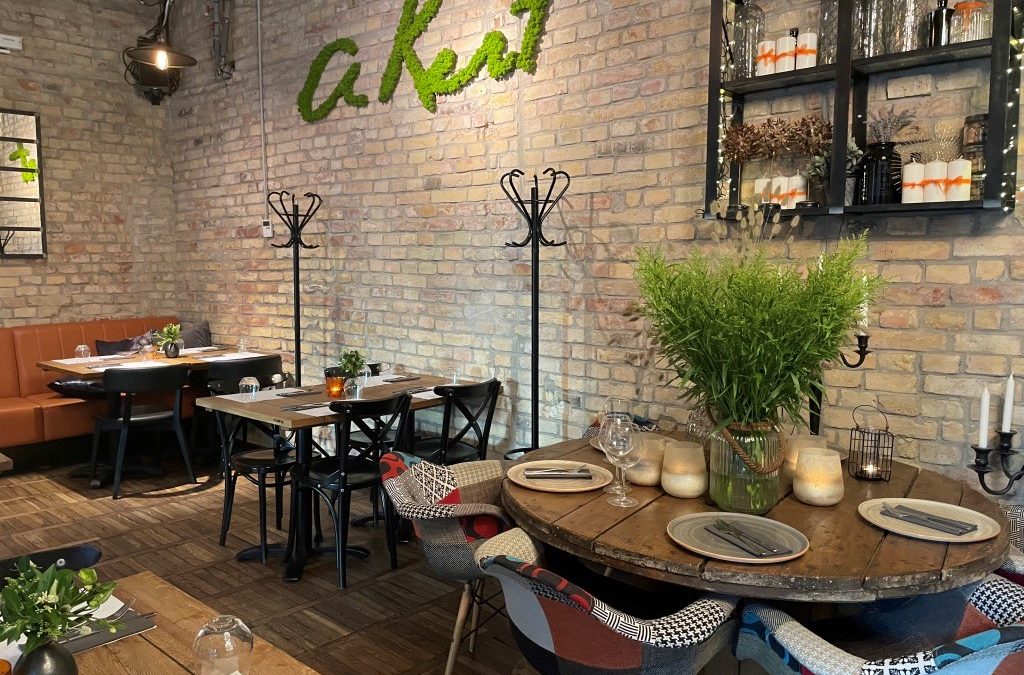
by HarcsasDorina | 07/11/2021 | 10 most romantic restaurants in Budapest
Are you looking for a gorgeous place to dine with your partner or being a tourist after the Covid-19 period?
In a city filled with glamourous spots and fascinating bistros, it is hard to distinguish which one is worthy to visit that would really impress when you have only few nights in a city. Also taking your partner to the closest restaurant in the corner is a great way to solve the hunger problem, however if you really want to astonish your partner, then you are looking for the best place for all the tips and tricks.
I traipsed around in search of the best places with unique food and breathtaking view from the restaurants. This article is going to provide you the most appealing places which will definitely give you an extraordinary experience to remember!
In no particular order, I will introduce you Budapest’s most romantic places…
1/10
A Kert Bistro

I had the chance to visit the Kert Bistro on the 18th of June, 2021.
Mediterranean á la carte menu with high- quality ingredients. Their cold sour-cherry soup with balsamic vinegar just blew our minds away. The salmon fillet with sweet potato fries on the side is meaty covered with caviar sauce seasoned with chives gave a complex journey of flavors. Closing up with their upgraded Sacher cake served with dried apricot ragout with apricot brandy which harmonized the sweet notes of the cake. Thirdly, the service is warm and inviting, with genuinely helpful staff waiting to make you feel part of the family. It all ensures that even if your date is a debacle, at least your experience at the Kert Bistro will be pure romance.

Tips and hints:
TABLE TO CHOOSE: ask for a table in the garden close to the bar
OUTSTANDING ROMANTIC FEATURE: The perfect balance of astonishing food in an environment that is spectacularly stylish but relaxed.
UNIQUE FOOD / DRINK: Salmon with caviar sauce seasoned with chives/ The Rose cocktail
PRICE RANGE: the affordable side of impressive. (Soups: 4-6 EUR, Main courses: 6-30 EUR, Desserts: 4-6 EUR)
2/10
Memorise Skybar
Visit: 24/07/2021
The Skybar is located within the Hotel Memorise Oldtown Budapest, which seamlessly blends a modern, but vintage feel. The gorgeous rooftop bar offers views over the Freedom statue and the city. Not only is there a palatable menu, but there’s also a huge cocktail list, as well as super cute lighting and intimate seating areas. The best way to start your night is with a cheese selection with huge olives and buckwheat bread which represents the revolutionize classic Mediterranean cousin. Kick the evening off with a cocktail. I was recommended to try their frozen daiquiri by the bartender.
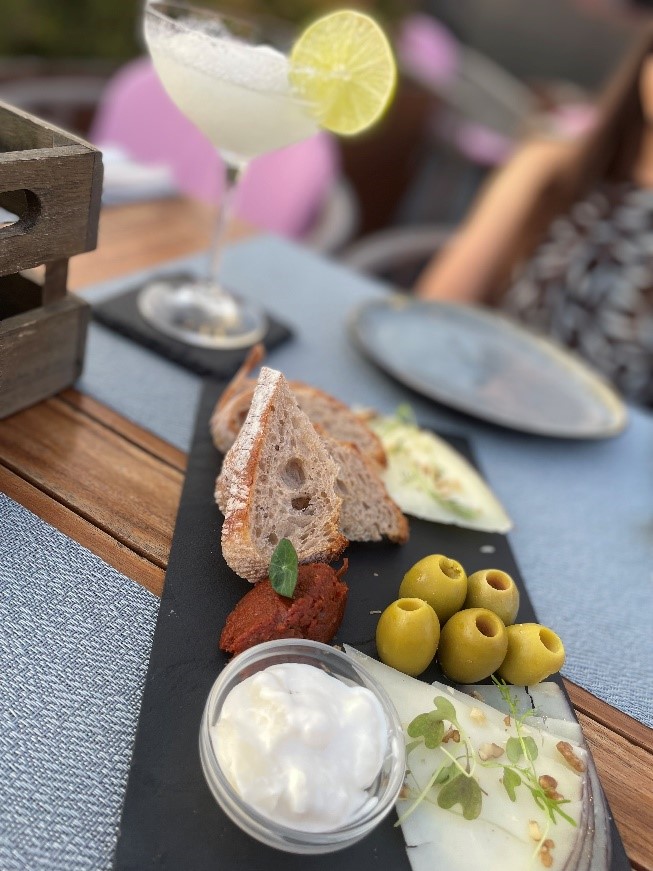
The trout filet with colorful grilled vegetables against the spinach foam was a masterpiece as well as the seasonal vegetable risotto. These were the excellent choices for a warm summer night. There is an option to ask for the daily offer which was salmon burger with sweet potato chips that night.

I would highly recommend not to miss out the famous Hungarian Somlói sponge cake which had the right harmony of the chocolate sauce and the caramellized walnut combination. Honestly, this dessert is unexpectedly rich in taste and will leave you smiling. I also tried their pistachio friench pastry dessert, however the taste was not my cup of tea.

The cuisine, the interior, the whole experience work beautifully and result in a memory that makes for a spoiling culinary treat.
Tips and hints:
Table to choose: the moment when you enter to the rooftop choose the table close to the far-right corner where you will experience the breathtaking view of the Citadella.
Outstanding romantic feature: The indulgent service which makes the evening feel truly special.
Unique food/ drink: Trout with grilled vegetables and spinach foam/ The frozen daiquiri
Price range: around 100 EUR for 2 persons. (Starters: 8-10 EUR, Main courses: 10-30 EUR, Desserts: 6-7 EUR)
3/10
Spago by Wolfgang Puck Budapest
Visit: 10/08/2021
Spago by W. Puck is one of the newly opened restaurant in the heart of Budapest. Situated in the Matild palace, on the left side of the Elisabeth bridge. Spago is perfectly poised to be your next pre-show dinner date spot. As a romantic restaurant is an excellent choice, however the fact is, this isn’t for every couples. Remove the club-like atmosphere and open up for a culinary experience in the Spago. The setting is key when it comes to cranking up the romance on a special date and, on this front, Spago will not disappoint You. The interior design takes cues from a classic sleek brasserie style, but details such as brass finishings.
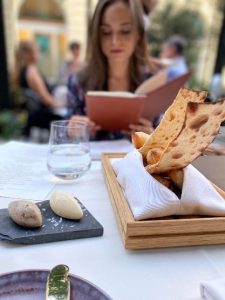 The restaurant aims to bring the spectacular Beverly Hills’ atmoshere to Budapest and provides exquiste dining experience.The welcoming apetizer bites,- freshly baked bread basket and home made butter & duck liver cream- keep you busy while waiting for your starters.
The restaurant aims to bring the spectacular Beverly Hills’ atmoshere to Budapest and provides exquiste dining experience.The welcoming apetizer bites,- freshly baked bread basket and home made butter & duck liver cream- keep you busy while waiting for your starters.
For starters, it is a must to try the signature salmon pizza with the optional caviar topping, what you will find in any Spago restaurant. A taste explosion, especially when washed down with a coctail offered by the waitress will give you the 360o experience. The hailroom tomato salad is highly recommended to order as a side apetizer because of its fresh ingredients.
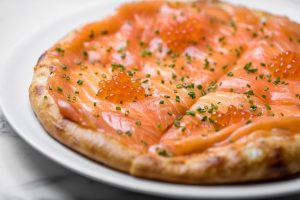
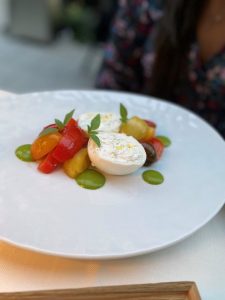

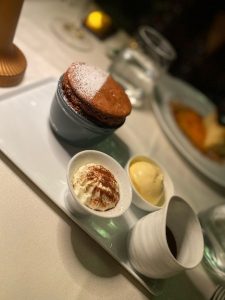
 For mains, there is a wide range of choice, however we would suggest to try the corn agnelotti with flavour composition of the mascarpone, the parmegiano, the sage and the corn in the middle. If you want to make the most of that dinner then I would advise not to leave without ordering the wood grilled New York steak with miso eggplant.
For mains, there is a wide range of choice, however we would suggest to try the corn agnelotti with flavour composition of the mascarpone, the parmegiano, the sage and the corn in the middle. If you want to make the most of that dinner then I would advise not to leave without ordering the wood grilled New York steak with miso eggplant.
To finish off, there is literally no dessert as romantic as a shared dark chocolate soufflé. It is served with vanilia icecream, melted chocolate souce and whipped Créme Fraiche.
Tips and hints:
Table to choose: Book a table tucked away in one of the corners of the inside sitting area.
Outstanding romantic feature: the intimate atmosphere and the flavors you won’t find anywhere
Unique food/ drink: Salmon pizza with caviar / Rough love
Price range: around 200 EUR for 2 persons. (Starters: 10-40 EUR, Main courses: 15-90 EUR,
Desserts: 8-15 EUR)
I am looking forward to sharing with you more about my next restaurant experience in the following weeks!
Link to find information about the current COVID restrictions in Hungary: https://koronavirus.gov.hu/gov.hu
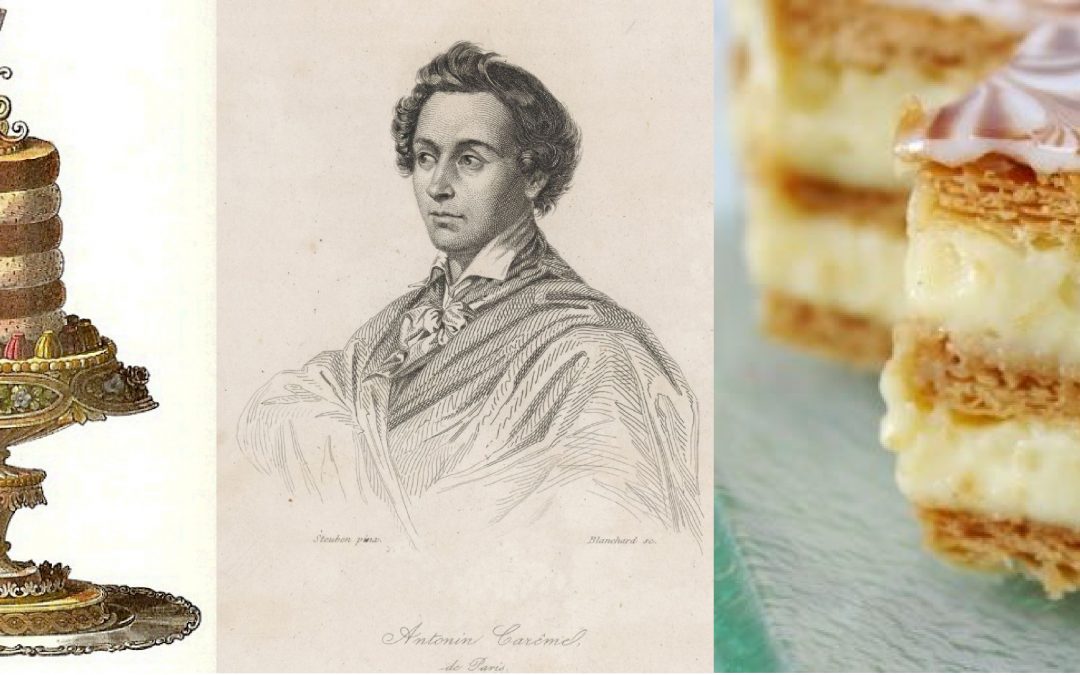
by HarcsasDorina | 05/16/2021 | Famous chefs
The name of Marie-Antoine Careme (1784-1833) is mainly known in professional circles, although difficult to overestimate its role in creating today’s top gastronomy and in the fact that French cuisine has become the basis of the culinary art of the world in its current form.
When we say that his name is associated with the invention of such cakes as mille feuille and corqueembouche that are extremely popular to this day or he was the first to make Bechamel sauce then many gourmets realize that they know and grant him.
Careme got only 49 years of life to raise his gastronomy to a level never seen before, to gain world fame and to lay the foundations of fine dining in today’s sense. Of this undeservingly short 49 years of life, he spent 40 years in the kitchen as he began his career at the age of 10, as a kitchen assistantt at a tavern as a boy completely abandoned by his parents in the storms of the French Revolution.
At the age of 16, Carême was already on his next job, this time at the imposing patisserie near the Palais Royal, owned by Sylvain Bailly.
Unlike the taverns — where he began his career — that operated intermittently and served the working classes, the patisseries were visited by the very wealthy class. During this time Carême learned to read and write and showed an interenst in architecture. He spent days studying in the library and then returned to the patisserie to reproduce classic architectural forms from sugar. Bailly, seeing the potential market for these creations, sold them as jewels of lavish bankets of the upper classes.
Within two years, members of France’s ruling class noticed the work of the young apprentice and commissioned him to produce special occasional pieces.
From here, the road was already straight to the position of head chef at Charles Maurice de Talleyrand-Périgold, the chief diplomat of Napoleon,where he gained considerable wealth and serious fame. He fundamentally changed the approach to eating, raising it to philosophical heights in his cookbooks.
King of cooks, cook of kings
He was the chef of the wedding of Napoleon and Mary Louis, then left France after the fall of the French emperor and he worked for King George IV of England and the Russian Tsar Alexander I and Emperor Franz Joseph I. It is no coincidence, that in addition to world fame, he earned the honorary title of King of Chefs, Chef of Kings.
Carême’s genius lay in his keen attention to detail, which he extended to all aspects of the meal, placing great emphasis on harmony, the order of processes, the balance of textures, the harmony of ingredients. As the host of the Congress of Vienna (1814 – 1815), he rearranged the gastronomic map not only of France but also of the whole of Europe.
Today, its name is mainly associated with the spectacular sugar, marzipan and cake sculptures called piéces montées, which he designed and built.
By the way, these are lavish finishes of fine dining to this day, but today’s chefs make it mostly from chocolate. Even though Carême’s true legacy comes from the systematization, rationalization and professionalisation of French gastronomy.
Carême – without exaggeration – was the first true maestro of haute cuisine: he was the first to distinguish rich, meat-filled, decorative, labor-intensive cuisine from regional French home cooking and was the first to catalog and organize all this knowledge for future generations. From the clutter of recipes and techniques, under the conditions of the time, he made four basic sauces, the so-called “mother sauces”, which are still the basis of hundreds of dishes to this day.
He divided his 482-page handbook Le pâtissier royal into two volumes containing sweet and savory recipes and also thematized them according to difficulty.
He was the first cook writer to use the phrase “you can try this at home”.
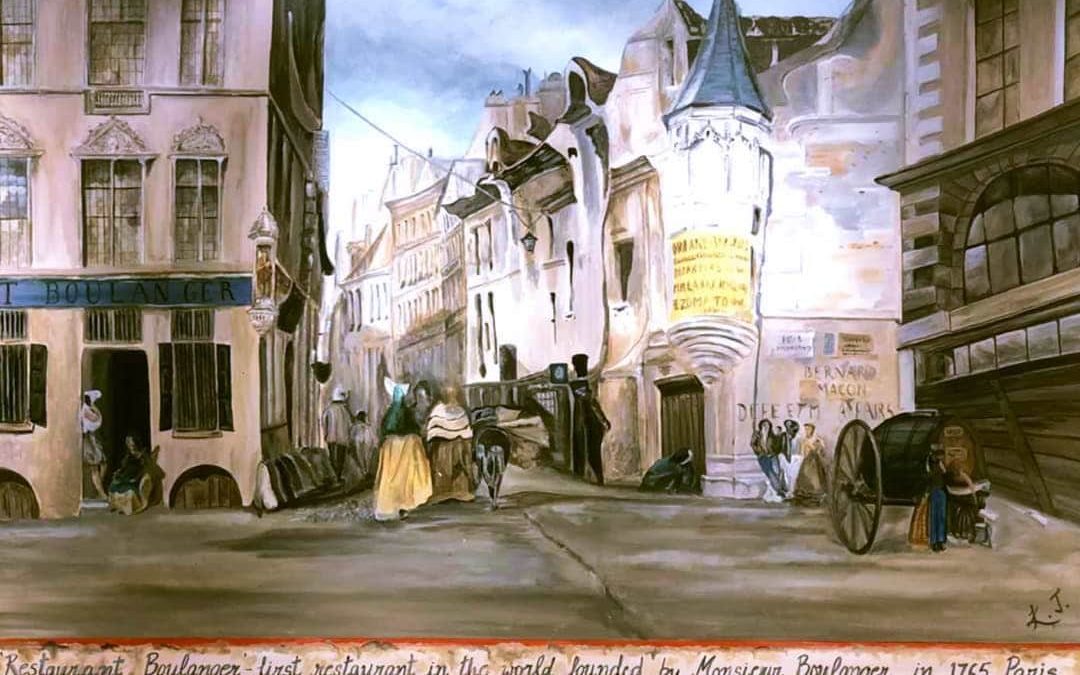
by HarcsasDorina | 04/24/2021 | History of famous Restaurants
THE VERY FIRST RESTAURANT IN THE WORLD WAS OPENED IN PARIS.
If we research the history of culinary art, we can certainly agree that it is worth focusing on France. The word restaurant itself, which is now widely spoken in many languages, is also of French origin, which surprisingly means a booster. But what needed to be strengthened?
The word and, in fact, the history of the restaurants can be traced back to 1765, when a French innkeepeer called Boulanger opened a “soup bar” near the Louvre called “Champ d’Oiseaux” where it sold soups made primarily for sick guests.
So we can say that golden broth of the weekend is not a modern-day invention: it has been a medicine for body and soul, for sick and healthy for centuries.
Boulanger’s soup gained rapid popularity, however, the innovative owner was not satisfied with the fact that he could merely serve broths, contrary to the practice at the time, offering lamb and white sauce to his guests after a while in addition to soups.
By doing so, however, he violated – the monopoly that strictly regulated the scope of activities of the guilds at the time. He submitted his unusual and revolutionary action to the guilds, with which he successfully persuaded them, thus paving the way for the rise of restaurants in the modern sense.
Twenty years after Boulanger, in 1785, the world’s first luxury restaurant opened its doors in Paris. The institution, owned by Antoine Beauvilliers, was called La Grande Taverne de Londres. The work of the founder-owner was even recognized by Jean Anthelme Brillat – Savarin, who described the strengths of the place as well as the excellent waiters in addition to the chefs.
The storms of French history, of course, also left their mark on the history of gastronomy: during the French Revolution, restaurants were understandably scarce, and chefs who raised to the skies before siwere left without work.
In 1804, the pre-revolutionary hospitality traditions in the French capital were revived: by this time, more than 500 such units were waiting for those interested in fine cuisine.
The up-moving middle class and the sliding aristocracy could not afford their own chef, so they began to go to elegant restaurants. However, their needs remained at the same high level: they expected a royal dining experience, gourmet cuisine, quality wines, sophisticated staff, an elegant venue that has created a thriving market today: fine dining restaurants in today’s sense have begun to emerge to meet growing demands. , where they could dazzle the demanding French aristocracy. The chefs working here have become “stars,” recognizing their efforts with high salaries that have elevated them to a higher social class.
We will continue from here;)
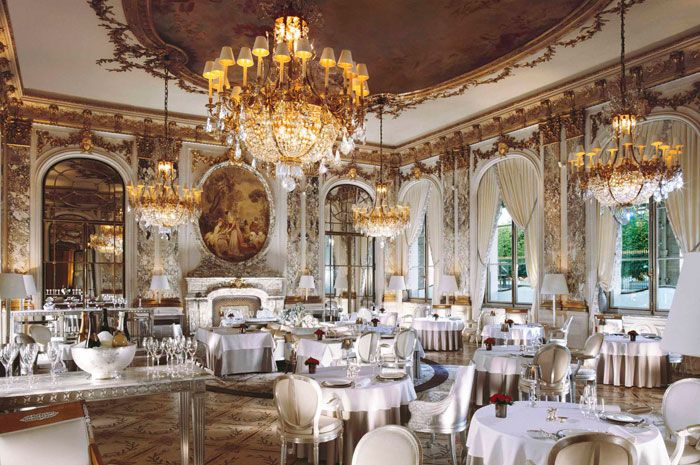
by HarcsasDorina | 03/28/2021 | Egyéb kategória
There is no easy situation for those who want to choose a quality restaurant these days for an important date, business dinner or major family event. We need to be aware of a concept unknown so many years ago: whether we prefer a bistro, inn or fine dining restaurant, rely on current restaurant reviews from Guide Michelin or Gault & Milliau compiled by strict professional judges, or go up Trip Advisor for a lay, but the more enthusiastic restaurant visitors share their experiences of the place and the food served, we may rely on the positions of famous people who are credible to us on social media.
Do we want to eat a lot or do we swear by the common trinity of quality ingredients – small portions – artistically composed facts in fine dining restaurants?
What is fine dining at all, who were Gault and Millau and what has a rubber factory got to do with the world’s top gastronomy? Are we moving forward enough if we don’t know what fusion cuisine is, but would we give our lives for our mother’s inimitable broth and fried meat on Sundays? How could eating at all have evolved from a basic life-sustaining instinct into a kind of artistic branch, who were the defining pioneers of this revolution?
There are many questions that we will answer in a readable form here in this forum in the coming weeks and months And before we get into these online gastronomic adventures – in addition to our own planned topics – we are happy to get topic suggestions from you on what you would like to read from usAlthough here, in the form of comments or even in a private message, we welcome your suggestions and prepare to the best of our ability
Wishes for a delicious Sunday lunch:
the team at The Perfect Service
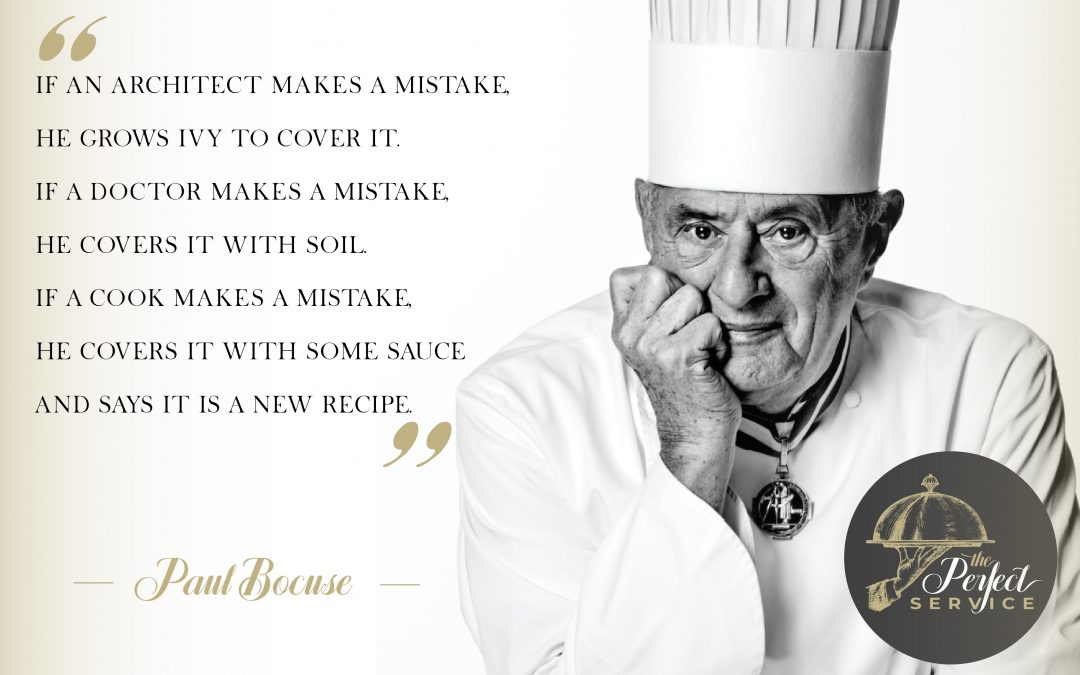
by HarcsasDorina | 03/19/2021 | Famous chefs
Paul Bocuse, the giant of French and world cuisine. (1926-2018.) Here’s a list of the most important moments and statements in his amazing career.
THE EARLY YEARS
– The only son of George and Irma, Paul Bocuse was born in 1926 in Collonges-au-Mont-d’Or, a few kilometres from Lyon.
– The epigone in a dynasty of cooks that first started in the 17th century, he first wore toque and apron at 16, in the middle of World War II, next to Claude Maret, chef at restaurant Soierie in Lyon. He soon joined the French army as a volunteer. He got a glancing bullet wound in Alsace and was treated by the Americans in the United States.
– His first masters include an important woman, Eugénie Brazier (1895-1977), La Mère Brazier, the mother of modern French cuisine. She’s the very first chef (male or female, it doesn’t matter) to get 3 Michelin stars in two restaurants at the same time: Rue Royale in Lyon and Col de la Luère in Luère. Bocuse arrives as a commis in the restaurant in the Alps. This is how he remembered her: «She was a strong and modest woman. She knew how to select the men and best products for her restaurant». A lesson he learnt from her.
– His training continued at the legendary Lucas Carton restaurant in Paris. Richard Gaston is the chef and the kitchen brigade includes Jean Pierre Troisgros, another pillar in French cuisine and an old friend of Monsieur Paul. In 1950 he goes to La Pyramide in Vienne, near Lyon, under the wing of master Fernand Point.
RECOGNITIONS
– In 1961 he’s MOF (Meilleur Ouvrier de France), a title that he said was the one that gave him the greatest joy. The same year he gets the first Michelin star. The highest prize from the Red Guide arrives in 1965, after the first (1961) and the second star (1962). No other restaurant in the world has had three Michelin stars for 52 years in a row.
– In 1975 he received the Légion d’honneur, the highest acknowledgement given by the French Republic. When he receives the letter signed by president Valéry Giscard d’Estaing he thinks it’s some kind of joke from a friend. That same year, so as to celebrate the occasion, he creates what is still his most famous dish, Soupe aux truffes VGE (the latter are the president’s initials). The original recipe? After breaking the puff pastry at the top, you can find a quarter of a litre of concentrated chicken stock, 20 grams of foie gras, truffles from Perigord, mushrooms cooked at length in butter.
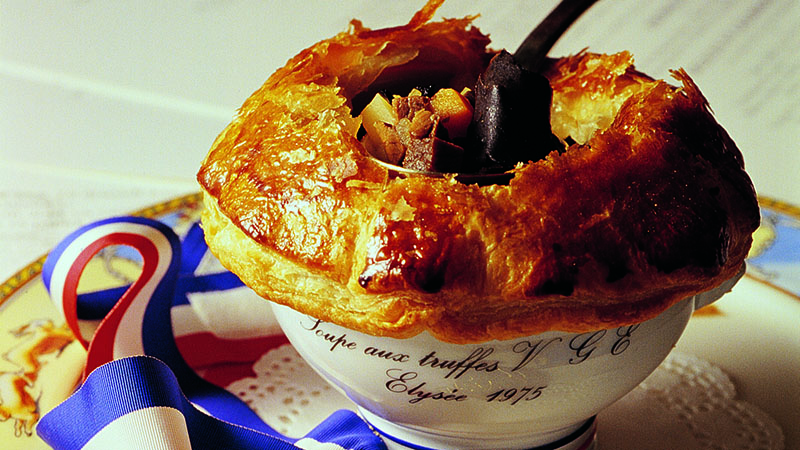
CHEF OF THE CENTURY
– In 1989, the guide of French journalists Henri Gault and Christian Millau, who signed the manifesto of nouvelle cuisine, nominate Bocuse as the “Chef of the Century”. A title he received 22 years later too, from the prestigious Culinary Institute of America.
RESTAURANTS
– In the following decades he opened 9 restaurants and brasseries in Lyon and the surroundings, such as Le Nord, l’Est, Le Sud and l’Ouest. He bought a plot in Beaujolais, and became a great collector. He also completed countless consultancy projects in Japan, the United States and Switzerland.
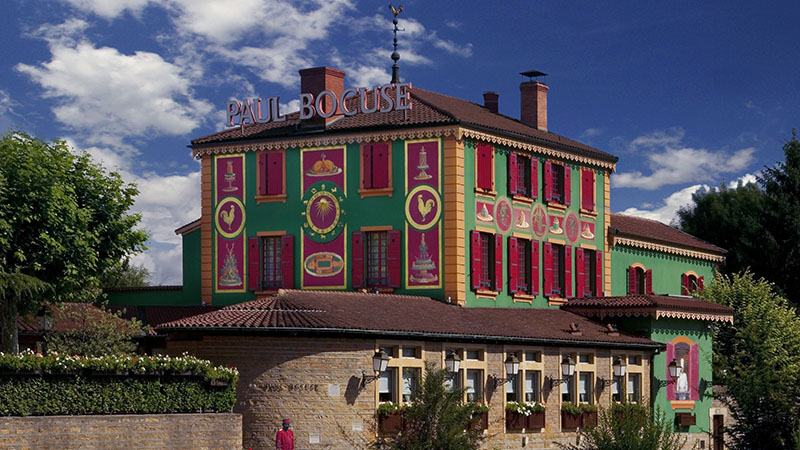
DISHES
– His dishes that went down in history include Duck with foie gras and pistachio, Bresse chicken fricassee with cream and morels, Duck foie gras in a gelatine of Porto in the style of Antoine Carême, French style Maine lobster salad, Sea bass filet with spaghetti à la Fernand Point, Mullet with crispy potato chips, Le President Maurice Bernachon cake. These recipes have strong hints at historic French fine dining, at the bourgeoisie and the institutions. Complex and strong dishes, rich in calories.

Speaking of digesting a meal, these words of his became famous: «If you want to feel good, go to a doctor». The implication: «Don’t come to my restaurant, I’m not interested in your digestion». It was a clear violation of the principles of Nouvelle Cuisine which, in a list from 1973 required light preparations and substituting fat and heavy sauces with lighter and easier to digest ones. Bocuse was one of the promoters of the manifesto, but had a conflicting relationship with the movement. He was too famous to fully take sides with a philosophy of which he shared the principles.
– His style of cuisine? «Unchangeable», said critic Par Thibaut Danancher, «A perfect match between cream, butter and wine», a triptych that was already dear, over a century ago, to Georges Auguste Escoffier, who catalogued French and world fine dining. «Why should I change a winning philosophy?», Bocuse always said, allergic to any fashion. And he added the famous sentence:
” I believe there’s only one cuisine: good cuisine”.
– Vegetarianism? Never: «Every respectable meal should always end with meat». Molecular? «Certainly not».
– French to the bone: «Our country is a huge fish tank defined by the Mediterranean Sea and the Atlantic Ocean, with a gigantic chicken farm in Bresse, and cattle in Charolais. From north to south we have have endless orchards, an unmatchable terroir and in the vineyards one can find the best of our ambassadors. No other country has this luck». Until two years ago, his menus were only available in his mother tongue.
A statement that later denied another famous quote of his:
“The hegemony of French cuisine will last until Italian chefs won’t realise the huge heritage on which they’re sitting”.
– His passion for women was also notorious. Three were his “official” partners, even at the same time, in what was defined as Bocuse’s trigamy. These were much more than clandestine affairs. He met Raymonde before the war, a young blond girl of 16. She held the reins of the restaurant for many years. In 1946 their daughter Françoise was born. In 1969 he started a relationship with hospital director Raymone, who gave birth to their son, chef Jérôme Bocuse, who has been managing the family empire for a few years now. The third woman is Patricia, whom he met only two years after Raymone. There’s a famous quote he told their daughter Ève-Marie, who curated Bocuse’s biography: «If I count the number of years in which I was faithful to the three women I met on my way, I reach 135 years of shared life». He also added, recently: «I have no regrets, except for the pain I caused to my women. I hope they will forgive me».
BOCUSE D’OR
– He loved sharing his profession with young people. This is why legions of cooks chose his school at Institut d’Écully. This is why he founded the Bocuse d’Or, now the most famous contest between chefs from different nationalities, first edition in 1987: «I’m very happy», he said, «that today many small Bocuses have become great cooks. It’s my greatest joy».
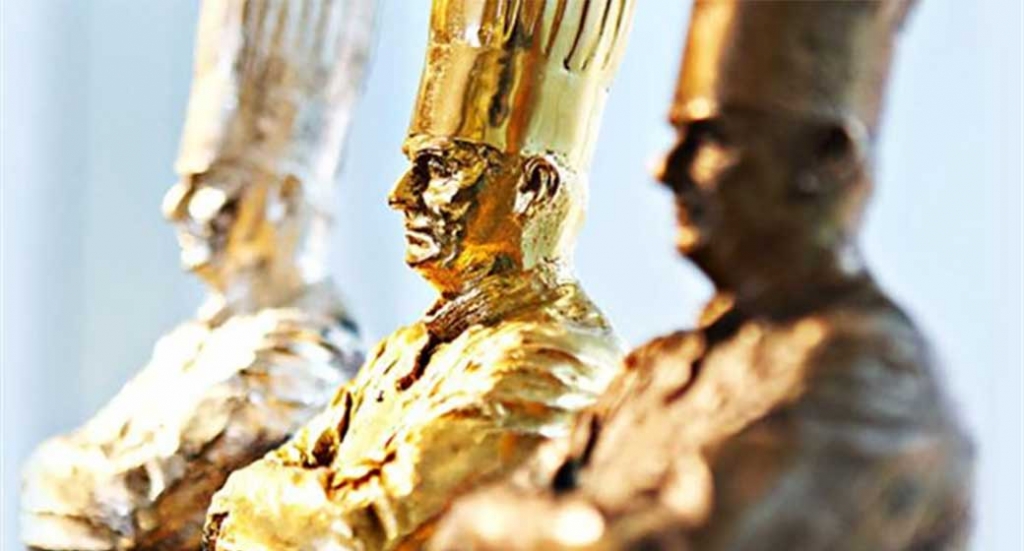
The pupils and colleagues who worked beside him are the Gotha of the French (and not just French) restaurant scene. Just to name a few: Alain Chapel, René Lasserre, Pierre Laporte, Gaston Lenôtre, Georges Blanc, Marc Veyrat, Roger Verger, Jean Troisgros, Pierre Troisgros, Raymond Oliver, PaulHaeberlien and Michel Guerard.
– In recent years many have considered the Auberge du Pont de Collonges as a not-to-be-missed stop, in order to understand the history of French haute cuisine in just one meal. On the other hand, it has been criticised because of its immovable menu and the fact it ignores contemporary ideas.
– As soon as he learnt of his death, friend and chef from Lyon Christophe Marguin, interviewed by Le Progrès, said without mincing words: «God has died». The farewells from young and old chefs are flooding social networks.
– He’d been sick for some time now, but he never stopped greeting guests at each table. He used to say:
“When I drive the bus of life and look back, I see many friends have already left. Sooner or later I’ll join them”.






 The restaurant aims to bring the spectacular Beverly Hills’ atmoshere to Budapest and provides exquiste dining experience.The welcoming apetizer bites,- freshly baked bread basket and home made butter & duck liver cream- keep you busy while waiting for your starters.
The restaurant aims to bring the spectacular Beverly Hills’ atmoshere to Budapest and provides exquiste dining experience.The welcoming apetizer bites,- freshly baked bread basket and home made butter & duck liver cream- keep you busy while waiting for your starters.



 For mains, there is a wide range of choice, however we would suggest to try the corn agnelotti with flavour composition of the mascarpone, the parmegiano, the sage and the corn in the middle. If you want to make the most of that dinner then I would advise not to leave without ordering the wood grilled New York steak with miso eggplant.
For mains, there is a wide range of choice, however we would suggest to try the corn agnelotti with flavour composition of the mascarpone, the parmegiano, the sage and the corn in the middle. If you want to make the most of that dinner then I would advise not to leave without ordering the wood grilled New York steak with miso eggplant.








